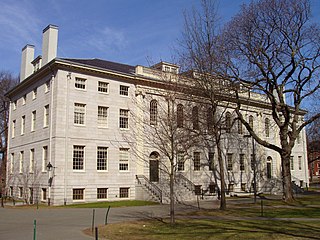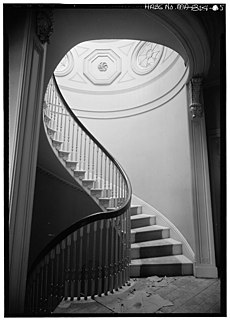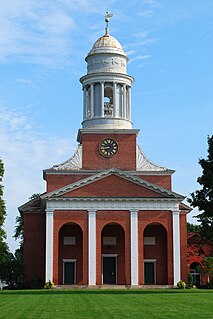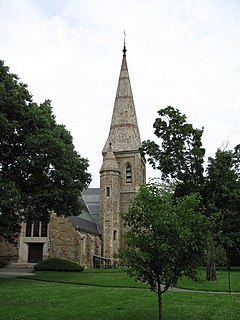
The Longfellow House–Washington's Headquarters National Historic Site is a historic site located at 105 Brattle Street in Cambridge, Massachusetts. It was the home of noted American poet Henry Wadsworth Longfellow for almost 50 years, and it had previously served as the headquarters of General George Washington (1775–76).

Elmwood, also known as the Oliver-Gerry-Lowell House, is a historic house and centerpiece of a National Historic Landmark District in Cambridge, Massachusetts. It is known for several prominent former residents, including: Thomas Oliver (1734–1815), royal Lieutenant Governor of Massachusetts; Elbridge Gerry (1744–1814), signer of the US Declaration of Independence, Vice President of the United States and eponym of the term "gerrymandering"; and James Russell Lowell (1819–1891), noted American writer, poet, and foreign diplomat.

Christ Church, at Zero Garden Street in Cambridge, Massachusetts, U.S., is a parish of the Episcopal Diocese of Massachusetts. Built in 1760–61, it was designated a National Historic Landmark as one of the few buildings unambiguously attributable to Peter Harrison, the first formally trained architect to work in the British colonies.

The Nickels-Sortwell House is a historic house museum at 121 Main Street in Wiscasset, Maine, United States. Built in 1807 by a wealthy ship's captain, the house was designated a National Historic Landmark in 1970 as an exceptionally high-quality example of the Federal style of architecture. After serving as a hotel for much of the 19th century, the house returned to private hands in 1900. It was given to Historic New England in 1958, which gives tours of the house between May and October.

University Hall is a white granite building designed by the great early American architect Charles Bulfinch and built by the noted early engineer Loammi Baldwin, Jr. It is located in Harvard Yard on the campus of Harvard University in Cambridge, Massachusetts. It was designated a National Historic Landmark in 1970 for its architectural significance.

The Nathan Appleton Residence, also known as the Appleton-Parker House, is a historic house located at 39–40 Beacon Street in the Beacon Hill neighborhood of Boston, Massachusetts. It was designated a National Historic Landmark for its association with revolutionary textile manufacturer Nathan Appleton (1779–1861), and as the site in 1843 of the wedding of his daughter Frances and poet Henry Wadsworth Longfellow. The house is an excellent early 19th century design of Alexander Parris.

The Maria Baldwin House is a National Historic Landmark located at 196 Prospect Street, Cambridge, Massachusetts, United States. The house is the northern half of a 19th-century two-family house, notable for its associations with educator Maria Louise Baldwin (1856–1922). It was her home when she served as the first female African-American principal in a Massachusetts school at Cambridge's Agassiz Grammar School. As master, she supervised 12 teachers, all white, who presided over a 98% white student body. The Agassiz School has since been renamed the Maria Baldwin School in her honor. The Baldwin House was declared a National Historic Landmark in 1976.

The First Church of Christ, Unitarian, also known as First Church of Christ, Lancaster and colloquially as "the Bulfinch Church", is a historic congregation with its meeting house located at 725 Main Street facing the Common in Lancaster, Massachusetts. The church's fifth meeting house, built in 1816, was designed by architect Charles Bulfinch, and was designated a National Historic Landmark in 1977, recognizing it as one of Bulfinch's finest works.

The Harriet Beecher Stowe House is a historic home and National Historic Landmark at 63 Federal Street in Brunswick, Maine, notable as a short-term home of Harriet Beecher Stowe and Calvin Ellis Stowe and where Harriet wrote her 1852 novel Uncle Tom's Cabin. Earlier, it had been the home of Henry Wadsworth Longfellow as a student. It is today owned by Bowdoin College. A space within the house, called Harriet's Writing Room, is open to the public.

The Joseph Story House is a historic house facing the Salem Common in Salem, Massachusetts. Built in 1811, this house was home from then until his death of United States Supreme Court Associate Justice Joseph Story (1779–1845), a leading jurist of the time, and an influential figure in the early years of Harvard Law School. A well-preserved example of Federal architecture executed in brick, it is a National Historic Landmark.

The Oliver Wendell Holmes House is a historic house at 868 Hale Street in the Beverly Farms section of Beverly, Massachusetts. Built c. 1880, this modest Victorian wood-frame house was designated a National Historic Landmark in 1972, as the only surviving structure associated with the life of Associate Justice of the United States Supreme Court Oliver Wendell Holmes Jr. (1841–1935), whose summer home it was from 1909 until his death.

Hamilton Hall is a National Historic Landmark at 9 Chestnut Street in Salem, Massachusetts. Designed by noted Salem builder Samuel McIntire and built in 1805–07, it is an excellent instance of a public Federal style building. It was built as a social space for the leading families of Salem, and was named for Founding Father and Federalist Party leader Alexander Hamilton. It continues to function as a social hall today: it is used for events, private functions, weddings and is also home to a series of lectures that originated in 1944 by the Ladies Committee.

The Mary Fiske Stoughton House is a National Historic Landmark house at 90 Brattle Street in Cambridge, Massachusetts. Henry Hobson Richardson designed the house in 1882 in what is now called the Shingle Style, with a minimum of ornament and shingles stretching over the building's irregular volumes like a skin. The house drew immediate notice in the architectural community, and was a significant influence in the growth in popularity of the Shingle style in the late 19th century. Richardson's masterful use of space in its design also foreshadowed the work of major 20th century architects, including Frank Lloyd Wright. The house was designated a National Historic Landmark in 1989.

The Gardner–Pingree House is a historic house museum at 128 Essex Street in Salem, Massachusetts. It is judged to be a masterpiece of Federal architecture by the noted Salem builder Samuel McIntire, and was designated a National Historic Landmark in 1972 for its architectural significance. It is owned by the Peabody Essex Museum as part of its architectural collection, and is open to the public for guided tours.

The Theodore W. Richards House is a National Historic Landmark at 15 Follen Street in Cambridge, Massachusetts. Built in 1900, it was the home until his death of Theodore William Richards (1868-1928), the first American to be awarded the Nobel Prize in Chemistry. Richards was a leading experimental chemist of his day, measuring the atomic weights of a large number of elements. He was also responsible for the growth of Harvard University's graduate chemistry program to one of the finest in the nation. The house was designated a National Historic Landmark in 1976.

The George R. Minot House is a National Historic Landmark in Brookline, Massachusetts. It is an architecturally undistinguished vernacular Colonial Revival brick house, probably built in the 1920s. The 2+1⁄2-story main block has an attached 1+1⁄2-story ell, and two end chimneys. The hip roof is pierced by gabled dormers, and a pedimented portico shelters the front entry.

The Old Cambridge Historic District is a historic district encompassing a residential neighborhood of Cambridge, Massachusetts that dates to colonial times. It is located just west of Harvard Square, and includes all of the properties on Brattle Street west of Mason Street to Fresh Pond Parkway, all of the properties on Mason Street and Elmwood Avenue, and nearby properties on Craigie Street. The district includes five National Historic Landmarks: Elmwood, the Reginald A. Daly House, the Oliver Hastings House, the Mary Fiske Stoughton House, and the Longfellow House–Washington's Headquarters National Historic Site, as well as several other houses listed separately on the National Register. The district follows the general route of the Watertown Path, an early colonial road that supposedly followed a Native American trail. This portion of the way became known as Tory Row during the American Revolution, because many of the fine mansions lining it were owned by Loyalists. In the 19th and early 20th centuries it continued by a fashionable location, and now features a number of architecturally significant buildings. It includes 215 contributing buildings and one other contributing sites over an area of 52 acres (21 ha). One included building is the Cambridge Historical Society's offices, which are in the NRHP-listed Hooper-Lee Nichols House, located at 159 Brattle Street.

The United States Customhouse is a historic and active custom house at 2nd and William Streets in New Bedford, Massachusetts. Architect Robert Mills designed the custom house in 1834 in a Greek Revival style. It has been used by the U.S. Customs Service ever since, and today serves as a port of entry.

Brattle Street in Cambridge, Massachusetts, called the "King's Highway" or "Tory Row" before the American Revolutionary War, is the site of many buildings of historic interest, including the modernist glass-and-concrete building that housed the Design Research store, and a Georgian mansion where George Washington and Henry Wadsworth Longfellow both lived Samuel Atkins Eliot, writing in 1913 about the seven Colonial mansions of Brattle Street's "Tory Row," called the area "not only one of the most beautiful but also one of the most historic streets in America." "As a fashionable address it is doubtful if any other residential street in this country has enjoyed such long and uninterrupted prestige."























